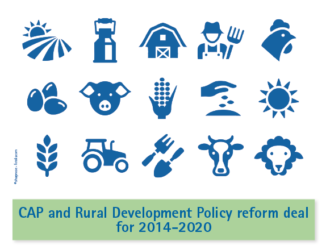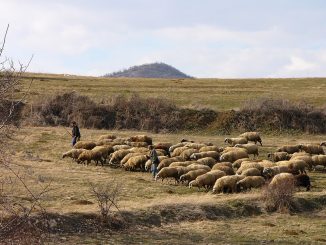Capping CAP payments at E60,000, a specific compulsory payment to small farmers, adjustment of basic income to basic income support “for sustainability”, changes in young farmer supports, and a move from rural development over to risk management via insurance are just some of the proposals in freshly leaked CAP proposals. Leaked document to download and ARC analysis below.
download the leak 25 April CAP draft legislative proposals from ARC2020
published 18.00 Hrs CET; section on nine objectives added 18.22 Hrs CET 25/04/2018
As Brexit budget realities bite, and as security, migration and other imperatives bear down upon the EU and its funding mechanisms, CAP may have to do, as it were, more with less. Judging by past CAP reform processes, the Member States, including the Council of Ministers when it convenes, may oppose much of what the Commission proposes. In particular, the idea of co-financing Pillar 1, argued for by experts such as Alan Matthews, is opposed by Ministers in the Member States. Intriguingly, co-financing of Pillar 1 was in the draft of the CAP communication, which we in ARC exclusively leaked last October only to be removed from the final version in November.
NEW (August 2019): Here is the June 2018 CAP Strategic Plans document from the Commission
Nevertheless, money will have to be used differently in the upcoming CAP. And indications so far are that this will be a mixed performance, if we consider what’s best for public goods such as generational renewal, fairness and agroecology.
New direct payment terms may be introduced, should this draft be adopted:
Types of interventions belonging to direct payments
1. The following types of interventions belong to decoupled direct payments:
– the Basic Income Support for Sustainability (BISS);
– the Complementary Redistributive Income Support for Sustainability (CRISS);
– the Complementary Income Support for Young Farmers (CIS-YF);
– the voluntary scheme for the climate and the environment (“Eco-scheme”).
There are also nine named specific objectives of the CAP. Member States need to design CAP support plans based on these objectives:
(a) Support viable farm income and resilience across the EU territory (to support food security);
(b) Increase competitiveness and enhance market orientation;
(c) Improve farmers’ position in the value chain;
(d) Contribute to climate change mitigation and adaptation;
(e) Foster sustainable development and efficient management of natural resources;
(f) Preserve nature and landscapes;
(g) Attract new farmers and facilitate their business development;
(h) Promote employment, growth, social inclusion and local development in rural areas (including bio-economy);
(i) Address societal expectations on food and health.
Below we list and give an ARC analysis some of the key ideas from the most recent CAP Communication leak. (Note this this leak is not a final or complete document)
Capping the CAP
Article 33 states “Member States shall cap the amount of direct payments to be granted to a farmer pursuant to [cross reference DP chapter] for a given calendar year at EUR 60 000.”
“Member States may use the excess product of capping within direct payments to finance other interventions belonging to decoupled direct payments….Member States may use the excess product of capping to finance types of interventions under the European Agricultural Fund for Rural Development….It would not be subject to the maximum limits for the transfers of funds from EAGF to EAFRD”
A ceiling as low as E60,000 placed on what farmers and landowners can receive from the public purse would be a significant change. This would be a substantial change from the E150,000, and in some cases 300,000 currently allowed. It has been difficult to justify the oft repeated point that 80% of CAP payments go to just 20% of recipients. Indeed, the entire notion of a CAP that provides public goods for public money has been difficult to make in the face of royalty and insurance companies pocketing incredibly large sums of money.
While this looks good on paper, there is opposition from some east European countries: as politico reported in January: “the Czech Republic has the EU’s largest farms by far: Its average size of 133 hectares per farm dwarfs the European average of 16 hectares.” The move from full to partial convergence in the previous CAP reform process still angers many east European Member States, as evidenced at the Agriculture and Fisheries Council meeting last month. There, there was a failure to agree on CAP conclusions, after agriculture ministers from Estonia, Latvia, Lithuania, Poland, and Slovakia refused to sign a joint declaration with the remaining 23 ministers.
Moreover, when the final decisions are to be made, this is the kind of thing that lobbying pressure form large agribusiness interests bears down upon.
Nevertheless, should this survive, even in amended form, it offers Member States an option for redistributing funds into the public goods sphere.
Top Up for Young Farmers
Article 42 states “Member States may provide a complementary income support for young farmers who are newly set-up for the first time.This complementary income support shall take the form of an annual, decoupled, payment per eligible hectare to farmers who are entitled to a payment under the basic income support. – good but not just for the big and digital guys.”
Note – There are direct payment, salary and labour conditions attached to this (potential) payment, the the rest of the wording of Article 42.
Due to low birth rates, more time spent in further education and longer longevity, all EU populations, including the farming population, are aging. While there is some disagreement about whether the farming population is aging more than other working populations, the farming population is an especially old one in any case: in the EU-28, 31.8 % of the agricultural labour force was below 40 years old compared to 42.4 % in the total working population.
Moreover, there are ever fewer young farmers (6% under 35 according to 2013 figures) and ever more older farmers (56.4% over 54 according to 2016 figures). The system of historic entitlements has not helped this situation change.
This payment could potentially act as a ‘workaround’ to the general block on young and new farmers entering the sector which historical entitlements cause.
Complementary Income Support (redistributive payments from large to smaller farms)
“Article 41 Complementary Redistributive income support for sustainability (CRISS)
For the purpose of ensuring redistribution of support from bigger to smaller and/or medium-sized farms, Member States shall provide for a redistributive income support in the form of an annual, decoupled, payment per eligible hectare to farmers who are entitled to [a payment under] the basic income support…”
“Shall provide” means that this is planned as compulsory. However, Member States will have flexibility to decide the amount(s) and size of area. It is noteworthy that Commissioner Hogan emphasised protecting small farmers in recent days.
This is a positive move, provided payments are linked to public goods such as agroecology and rural development.
Greening
Greening is not named in the 95 page leaked document. This may be significant : greening has come under severe criticism, most recently from the European Count of Auditors who found that only 5% of land use changed because of greening, despite the severe environmental need for change.
While BISS (Basic Income Payment For Sustainability) and a voluntary “eco-scheme” are named, there is no reference in the document to anything that might be “sustainable” or “eco” about them.
However, what is in the document that most relates to greening-type measures are in article 43, titled Voluntary scheme for the climate and the environment “eco-scheme”.
If taken up by Member States, this article states that: “Member States shall lay down the practices in respect of which payments are made under the scheme. Those practices shall be designed to meet one or more of the specific environmental and climate objectives…
Member States may decide to support under this type of intervention genuine farmers who make commitments to observe….agricultural practices beneficial for the climate and the environment.”
This is a broad,vague and under-developed article – climate change, ecological focus areas, or transitioning to resilient farming systems are not mentioned.
Risk Management Tools
Article 50 “…Member States may grant support under this type of intervention in order to promote risk management tools, which help farmers manage production and market risks related to their agricultural activity and outside the farmer’s control.
3. Member States may grant in particular the following support
(a) (a) financial contributions to premiums for insurance schemes;
(b) (b) financial contributions to mutual funds, including the administrative cost of setting up…”
Risk is mentioned on page one of this document, but the focus is mostly on risk management. And what’s promoted is a quite specific way to manage risk, one that could be seen as enabling and then ingraining damaging practices – the ones making life on earth, as it were, risky.
The focus here is on adaptation via insurance mechanisms, not on agronomic adaptation. Indeed, the focus of article 50 seems to be the introduction of insurance schemes, compensation and other forms of ‘adaptation’ to the problems – like increased extreme weather volatility – which agri-food is contributing to via its climate change footprint. If bailouts and debt to insurance companies become standardised, as risks increase, where is the support for changing practices? Why would a farmer go through the process of introducing agroforestry to deal with flooding and climate change, when the insurance and aid package will set narrower, short term parameters and techno-fixes?
Moreover, is this new approach backgrounding community led rural development, and the building of bottom up capacity in value chains? References have been made to improved training for understanding insurance – for farmers and advisors, as part of rural development. “Risk management” is not about dealing with the root causes of the risk: it will however, make the farming dependent on the financial sector, especially on insurance companies.
Conclusion
Macro financial realities for the EU and an aging farming sector, with little inter-generational renewal, appear to be pressuring the Commission to do something significant about how money is distributed in the agri-food and rural sectors via CAP. Capping the highest CAP payments, while re-orientating towards younger and smaller farmers can be seen as a positive.
However, in many other respects this is a worrying draft leak. Enabling significant change in agronomic practices, toward agroecology, is nowhere to be seen. The move into risk management does nothing to help in this regard, and is in fact a step onto a specific path – once of farmer debt and ingrained bad practices. it is not at all clear what greening – however flawed it currently is – is to be replaced with.
Upcoming next steps
May 29th approval by College of Commissioners
June 3-5th Informal Farm Council in Sofia
A more considered ARC2020 response will be presented in the coming days.





The insurrance companies are very keen on attracking new possibilities like mentionned above. Given the situation that large bank and insurrance companies are clossely linked to the farm organisations (COPA) there will be no opposition to this from COPA, (and this will make a new burden fot the farmer( i.e. there was always a govt action in Belgium when there was far too much rain, so farmers got money from the govt; but once this new scheme is in practice, the Belgian govt won’t give anything anymore) But I foresee a great opposition to the limit of 60.000 euros